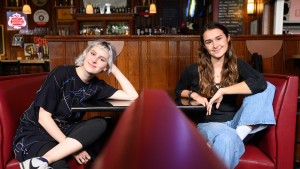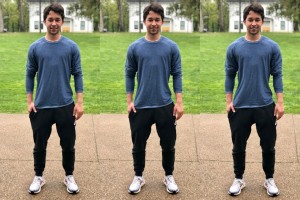“I am deeply interested in exploring topics in which artistic expression and science, the humanities and science, overlap. As an artist, I am also familiar with the ways art and science can enrich, and sometimes mirror, each other.” — Sarah Wagner ’23 (above, left)
“Coming from a multi-generational fishing community, I have grown to love the human aspects of ecology as much as the scientific curiosities. I have been drawn to fisherman’s tales since I was little, and I am incredibly interested in the different ways that the natural world is relayed through story. For this reason, I find myself interested in the narratively driven character studies within science writing, the pieces that uncover the intricacies of human endeavor behind the scientific facts we read about.” — Liv Kane ’22 (above, right)
The Hoskins Frame Summer Science Writing Scholar positions were created through a gift from Rick Hoskins P’22, a member of the Board of Trustees, and Lynne Frame P’22. The positions provide a pathway for students to explore scientific storytelling with mentoring by the Mellon Science Writing Fellow, Geetha Iyer, as they pursue individual projects and other writing within the College’s communications division.
President Sean Decatur has supported and championed the development of team-taught, humanities-based science writing courses that require students to step out of their areas of specialization, whether physics or poetry, neuroscience or creative nonfiction, to re-contextualize how they view and think about the world, understanding that the need to communicate clearly to a broad audience is critical to tackling the scientific issues of our times.
Chris Gillen, professor of biology, chairs Kenyon’s science and nature writing steering committee and has co-taught ENGL 404: “Science Writing” with Professor of English Sergei Lebanov-Rostovsky. “We have an expansive view of science and nature writing. Our approach is to bring the creative writing up against science and see where that takes us,” he said.
The new high-impact experience, modeled off the competitive Kenyon Review Associates and Summer Science Scholars programs, drew enthusiastic interest from students in its first year, Gillen said. “It’s a unique and creative approach, the fact that they are interacting with a mentor who is working with them on their writing, but also interacting with scientists, getting to embed, and also the connection to communications. This is a real professional development opportunity for them, it’s so different from what happens in class.
“Also, because it’s such a collaborative project, this is the kind of thing that — in addition to being great for the students — it helps us build relationships with faculty and staff that are foundational to making this kind of interdisciplinary project,” Gillen said.
Hoskins said he and his wife have always had a shared love of the arts, so the idea of supporting a creative endeavor, which also aligned with a priority for the College, appealed to them. As they considered where to direct their philanthropy at Kenyon, they drew on the experience of a friend who worked on a video project in the Sahel region of Africa, in which children were invited to submit ideas and the winning entries were made into short films starring and directed by well-known African artists. “Part of it was about educating communities about AIDS, breaking down taboos, using humor. It was a really simple idea, but it was so powerful,” Hoskins said.
As it happens, Kane’s summer independent project is a documentary mini-series examining the more humanistic aspects of science labs. “I mainly wanted to film people nerding out and getting excited about what they love, and I have an awesome opportunity to do that with both students and professors in the labs I’m embedded in. What makes people so excited about the science they pursue? And what does that tell us about the human experience as a whole? I’ve enjoyed every second of excitement, vulnerability, and genuine awe that’s come from the people I’ve worked with, and my hope is to continue making films around passionate scientific work for a wider range of audiences,” she said.
For Frame, the combined pursuit of writing and science is lifelong: she earned her bachelor’s from Stanford University in interdisciplinary human biology and her Ph.D. from the University of California, Berkeley, in German literature. She is involved with Slow Food International, a non-profit organization that promotes local food traditions and focuses on sustainability and access to nutritional food around the world. Based in Italy, its Slow Food University offers a graduate degree in food journalism, which Frame says is built on the concept of the power of writing and communication to advocate for change, particularly around the environmental causes she champions. “The environmental angle for a gift was of interest to us, then writing as the approach to environmental impact in the long run aligned well with Kenyon,” Frame said.
Decatur, a biochemist, has advocated for and written about how storytelling fuels scientific research. “Rick and Lynne clearly understand the value this immersive, supported summer experience can have for our students, including Sarah and Liv. We look forward to what these Summer Science Writing Scholars will publish and create in the future as well as the ways in which their work will inspire other writers at Kenyon across disciplines,” he said.
Thanks to the gift from Hoskins and Frame, there are plans to expand the program to five Science Writing Scholar positions in the future. It comes as part of the Our Path Forward to the Bicentennial campaign, which has a goal of $500 million by June 2024.
“Philosophically, what really appeals to me about our gift is the thought about what it could become and what it’s going to be 10 years from now, when we can revisit the scholars who have gone through the program and see where they’ve gone onto. I just think that’s one of the cool things about giving,” Hoskins said.
Wagner hopes to draw on her experience to get her Ph.D. and become a neuroscience professor, while continuing to write for the general public. This summer, she has been sitting in on Professor of Physics Tom Giblin’s cosmology lab, working both on understanding and asking questions about their work, and on translating it to a general audience. “This process has definitely had a learning curve, as physics is an area I have very little experience in compared to other scientific fields, but it’s been extremely rewarding and fascinating. The piece I’m working on about the lab right now is focused on illustrating the lab’s ‘vibe’ to an unfamiliar audience, especially its focus on curiosity and question-asking in all its forms, in a humorous (but true-to-life) way — they laugh a lot in this lab,” she said.
Said Hoskins: “You realize how important storytelling is for us as a species, for our culture. If you think back over the thousands of years we’ve been on this planet, the thing that has moved us forward and has been with us is our stories.”
Read a story written by Sarah Wagner ’23 as part of the Hoskins Frame program:

